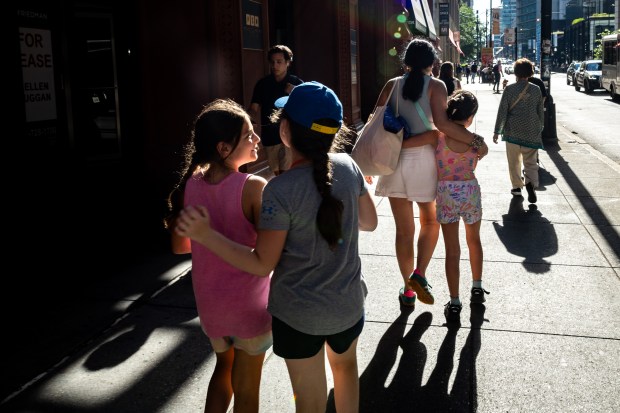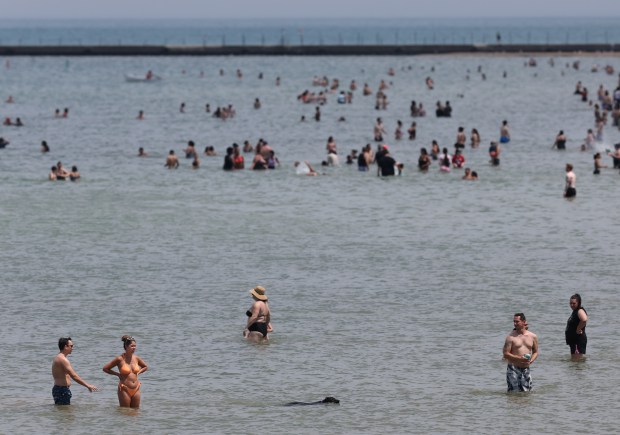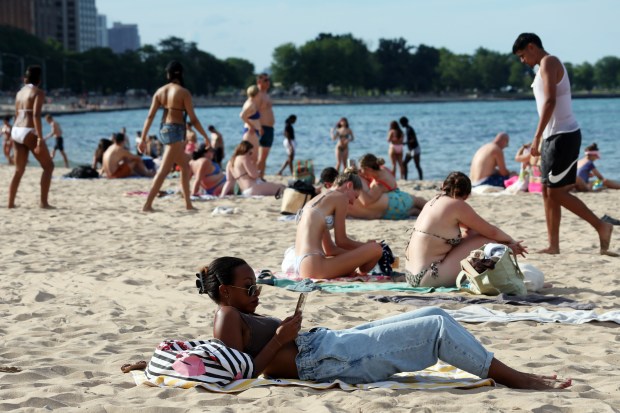As heat waves around the globe break records month after month, climate change is manifesting in more nuanced ways across the Midwest. Summertime feels stickier, and humid nights offer little relief from the oppressive daytime heat.
“It starts to feel like you’re walking through soup,” said Trent Ford, the Illinois state climatologist. “And it’s really, really gross, but also dangerous.”
But summer highs in recent years are rarely record-breaking for Chicago, unlike periods with severe droughts such as 1988 and 2012, when dry air drove up temperatures.
Climate change is accumulating humidity in the region — between 1895 and 2019, average precipitation in Illinois increased by 15%. A moist atmosphere ramps up heat indexes, meaning the weather feels worse to the human body than it would during drier conditions.
Nights are also hotter when it’s humid, which can have serious health implications because that extends exposure to uncomfortable temperatures.
“It’s not just the peak warmth, but the duration that it lasts,” Ford said.
In Chicago, overall summer average temperatures have warmed by 1.5 degrees between 1970 and 2022, but that’s not the whole story: Average lows on summer nights have increased by 2.2 degrees in that same time.
During the heat wave in mid-June, Chicago set a record high of 97 degrees for June 17, according to National Weather Service records dating back to 1871. But low temperatures the next night broke a record, too, as they hovered at an uncomfortable 78 degrees, marking the hottest June 18 evening in over 150 years.
“It is a problem that we see in some of the major heat waves that we’ve seen in the U.S. and around the world,” said Andrew Pershing, vice president for science at Climate Central, a climate science nonprofit. “The daytime temperatures get a lot of the attention, and they’re super stressful. But if you’re in an apartment that can’t cool down at night, it’s really easy to get into a dangerous situation.”
Higher nighttime temperatures can lead to insufficient or poor sleep, which experts say can in turn compromise the immune system, increase the risk for cardiovascular disease and diminish cognitive performance.
This week in Chicago, the air has been thick with moisture as scattered rains pelted the city. The rest of the week is expected to be the same with the possibility of severe storms — for which heat and humidity make conditions more favorable. Officials said Thursday, the first day of Chicago’s annual Lollapalooza festival, was expected to near 90 degrees.
With storms and heat forecast for Lollapalooza, festivals mull how to adapt to climate change
The threshold for what is considered a hot night differs by location and how acclimatized its residents are to heat. Residents of southern Gulf of Mexico states, for example, would experience heat differently from Chicagoans.
Meteorologists said Wednesday night was forecast to be 70 to 73 degrees, which would be higher than 95% of historical summer minimum temperatures. The nighttime low for Thursday was forecast to be 69 to 72 degrees.
In Chicago, 25% of summer minimum temperatures were abnormally hot in 2020 and 2021, with lows averaging 66.8 degrees, which is a 7.9-degree increase since 1960, according to The New York Times.
For context, people don’t need cooling to be comfortable indoors when outside temperatures are under 65 degrees, according to weather experts. So hotter summers are driving cooling demand and electricity bills across the nation; in parts of the Midwest, including Illinois, average household costs of cooling this summer are predicted to be $581, up almost 10% from $524 last summer.
Warmer nights occur when the atmosphere is waterlogged. Clouds form and reflect incoming heat from the sun back into space during the day, but after the sun sets, clouds absorb heat from the surface and emit it back toward the ground.
Just like greenhouse gases trap heat, moisture holds onto heat in the atmosphere for longer and into the night. Rising temperatures, in turn, lead to rising humidity: For every 1.8-degree Fahrenheit increase in temperature, the atmosphere can hold 7% more water. It’s a never-ending loop.

This cycle has marked summertime in Chicago so far.
During the morning commute Wednesday, temperatures were already in the high 70s. People walked their dogs near a busy intersection in Lakeview. A woman crossed the street in a light jog, her clothes soaked with sweat.
Even in the early hours of the day, sticky heat seemed inescapable.
More water vapor in the air makes it harder for people to sweat efficiently enough to cool down, which is why exercising outside on a humid summer day can feel much worse than doing so on a similarly hot but dry day. Even under the same kind of physical exertion, sweat would drench clothes and skin much quicker and more easily during a muggy day.
Sweat can be a nuisance, but it’s how human bodies keep cool and release moisture, which then evaporates, according to Pershing. That evaporation happens more easily in dry environments because, in humid environments, water already saturates the air, slowing the process.
On dry days, cooler morning temperatures rise quickly as the sun comes up and drop as soon as it sets. But on humid days, temperatures can already be high early in the day and not spike as much when the sun comes out, or drop much in the evening.
“It doesn’t get quite as warm quite as quickly as it would in dry situations,” Ford said, “but if you’re working outside, you’re being exposed to high heat and humidity over a longer period of time, and certainly at night.”
Heat waves are hotter and cooling costs are rising in cities such as Chicago, studies show
Nighttime lows on Friday and through the weekend are forecast in the low 70s in the city, said weather service meteorologist Todd Kluber, which is a couple of degrees above average.
On a recent hot stretch from July 13-15, high temperatures at O’Hare International Airport reached 91, 88 and 90 degrees, respectively, and low temperatures dipped to 67 on the first two days and to 69 on July 15. Those overnight lows weren’t as bad as the record-breaking June night, and daytime highs were not too far off average, said Brett Borchardt, a meteorologist with the Chicago office of the National Weather Service.

But moisture in the air made it feel “a lot worse,” he added.
“In terms of heat waves, certainly not a record-breaker, but still quite uncomfortable when you factor in the humidity,” he said. “The 15th was the most humid day around the Chicago area, and the (heat index) got up to about 100 to 105. It was warmest if you went further south and west, away from the lake. And we find that when the heat index is above 100 and especially 105, that’s when heat-related illnesses really start to crop up.”
Heat stroke, when the body can no longer control its temperature, is the most serious heat-related illness and can be fatal without treatment.
Officials believe heat may be to blame for more than 90 deaths reported in the West during a July heat wave, though it could take months of investigations for the authorities to determine an accurate death toll, according to The New York Times.
For 13 consecutive months, every month has broken temperature records globally with an average of 2.7 degrees Fahrenheit above pre-industrial levels, or the concentration of heat-trapping greenhouse gases in the atmosphere due to industrialization, the Copernicus Climate Change Service in Europe reported.
Copernicus reported that on July 22, the daily global average temperature reached a new record high of 62.88 degrees Fahrenheit, beating a record of 62.76 degrees set just one day before.
Pershing, of Climate Central, said it’s understandable that the focus is drawn to summer high temperatures across the world since that’s what most people experience when they’re outdoors during the day. But in the Midwest, the most telling trends are evident in nighttime temperatures.
“The warming trends that we see in the Midwest are not as strong as we see to the east, southeast and southwest, certainly, and probably humidity is playing a really important role in masking that, which is why in the Midwest, I think, you’re going to see a much stronger response at night,” Pershing said. “In many ways, it’s really subtle, but in many ways, it’s some of the best evidence that we are looking at an altered climate and not some kind of natural variability.”



